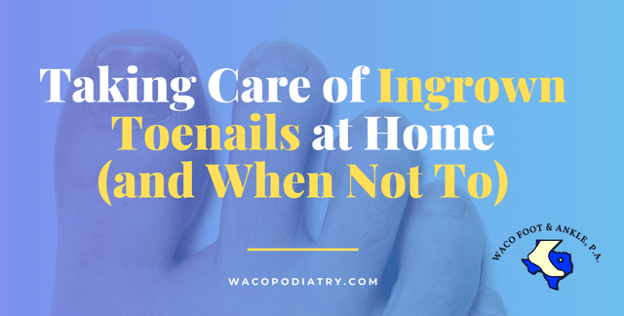Taking Care of Ingrown Toenails at Home (and When Not To)
When it comes to “urgent foot and ankle matters,” most people probably won’t put an ingrown toenail first on their list. That’s understandable, as the problem tends to present itself as more of a nuisance than anything else.
However, there are also times when an ingrown toenail is something that should be seen by a professional, and may in fact require proper treatment even during a time when everyone is being asked to stay at home as much as they can.
Our office does remain open for your foot and ankle needs, and certain cases of ingrown toenails do count as urgent matters.
We’ll describe some situations when you should absolutely call us regarding your ingrown toenail trouble, and then provide a few tips for treating a minor case at home.
But before all that, please know this: If you ever have questions about whether an ingrown toenail (or any other foot or ankle problem) is worth coming to see us as soon as possible about, never hesitate to contact our office and ask. Our mission is to provide you our best advice and recommendations for the situation at hand, and we will always do our best to guide you correctly.

When an Ingrown Toenail Needs Special Attention
While some mild ingrown toenails can be handled at home, we highly recommend giving us a call if any of the following situations apply to you:
- Your ingrown toenail is especially painful. If simply touching the nail is enough to cause you agony, that is a sign that something could be seriously wrong, such as an infection. You also don’t deserve to slog through such misery when we have ways to handle your problem more comfortably!
- Your ingrown toenail is showing any other signs of infection. In addition to severe pain, other symptoms of a potential infection include the site being extremely warm to the touch, discharge of pus, and red streaks that radiate out from the injury and seem to be spreading. A fever can also be possible in some cases. If you ever have concerns about an infection, do not hesitate to call.
- You also have diabetes. The effects of diabetes on the feet over time can cause any form of injury—no matter how small—to become more likely to develop an infection or other complications. We won’t ask you to come in for every little bump and bruise you experience, but letting us know what you have going on can help us determine whether something needs a closer look.
- Your ingrown toenails keep coming back. Even if your ingrown toenails are mild, there is something wrong if you keep getting them all the time. Sometimes tight footwear or improper toenail trimming habits are to blame, but it’s also possible that you were simply born with toenails that tend to grow curved and inward on their own. In these cases, we may recommend a minor, in-office surgical procedure to remove the nail and clear up the problem for good.
If none of the above factors apply to your particular case, then your ingrown toenail is likely a good candidate for at-home treatment.
Treating an Ingrown Toenail at Home
The process is actually quite simple. Here is our recommendation:
- Soak your feet in warm water for 15-20 minutes. Adding some Epsom salt or a very mild soap detergent is fine, as long as it does not cause your feet any irritation or pain. Soaking helps relieve swelling and pain.
- Once finished, gently pat the area dry.
- Apply antibiotic ointment and an adhesive bandage to protect the toe.
That’s about all there is to it. Soak your feet a few times through the day if you can, but remember to apply a new dose of ointment and a fresh bandage each time you do.
Some sources say you should slip a small piece of cotton or dental floss beneath the nail to help guide it away from the skin. This method may not always be the best, because it introduces more foreign matter that can get stuck and potentially increase infection risk. If you do decide to go with this trick, please make sure to fully remove the material before each new soak and replace it with a clean, new piece afterward.
When not soaking, try to keep your foot out of shoes or in a good pair of sandals. If you have to wear shoes, opt for a pair with as roomy a toe box as you can manage.
Your ingrown toenail should start to improve and feel better after a day or two of such treatment. If it does not—or even starts to feel worse—you know what to do: give us a call!
Get the Help You Need for Ingrown Toenail Pain
If home treatment for an ingrown toenail is not going as planned, or you have one of the above complications, we can provide the prompt help you need.
And if you are coming in during the time of COVID-19, please rest assured we are screening patients before scheduling their appointments, as well as taking many precautionary cleaning and protocol measures to provide as safe and low-risk an environment as possible for our patients and staff.
Call Waco Foot & Ankle at (254) 776-6995 to schedule an appointment or discuss other options with us. You can also contact us electronically by filling out our online form. A member of our staff will respond to you during our standard office hours.
